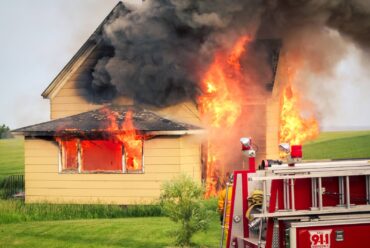 Did you know you could have less than three minutes to safely leave your home in the event of a fire? While the overall number of home fires has decreased recently, home fire deaths are actually on the rise.
Did you know you could have less than three minutes to safely leave your home in the event of a fire? While the overall number of home fires has decreased recently, home fire deaths are actually on the rise.
Fire is faster today due to synthetic materials, lighter construction materials and open floor plans. Smoke is even faster. Unfortunately, many families don’t prioritize fire escape plans as part of their regular routine. The annual consumer fire safety survey from the Fire Safety Research Institute (FSRI), part of the nonprofit safety science organization UL Research Institutes, reveals that 1 out of 3 Americans (32%) do not have a fire escape plan for their home. Of those who have a fire escape plan, 21% say they have never reviewed or practiced it. Respondents who do not have a fire escape plan most commonly say it’s because they’ve simply never thought about it (51%).
For Fire Prevention Month this October, FSRI shares vital tips to help keep your household safe.
1. Create and practice a fire escape plan.
Map out Escape Plans A, B and C for every room in the house, then practice your plans regularly with everyone living in the home. If you can’t see a way out for Escape Plan A, that’s when you turn to Plan B and get out another way. If those routes are blocked, get behind a closed door, turn on the light and dial 911 — plan C.
Everyone in the household needs to know Plans A, B and C by heart, plus a meeting place outside the home so each household member can be quickly accounted for in an emergency.
2. Have working smoke alarms properly installed in your home.
Smoke inhalation is the leading cause of death in home fires, but only 6 in 10 people surveyed know that. Because smoke is filled with toxic chemicals, it creates fumes that can disorient you, and when toxic levels are high enough, a single breath can burn your lungs and endanger your life.
Smoke moves rapidly: Within seconds after a fire ignites, smoke spreads across the ceiling. Within minutes, smoke from a fire in one room can fill a one-story home or apartment — everywhere that isn’t blocked by a closed door.
The longer fire burns, the thicker and more toxic smoke gets, preventing you from seeing your way out. Smoke alarms give you and your loved ones the earliest warning possible so you can get out of your home quickly and safely.
Install smoke alarms in every sleeping room, outside each separate sleeping area and on every level of your home, including the basement. Test your smoke alarms regularly to ensure they are working.
Smoke alarms should be tested at least twice per year. Smoke alarms have a test button. Push and hold the test button. If it’s working properly, you’ll hear a very loud beep. If the sound is weak or no sound comes out, replace your batteries or the entire alarm if it’s a sealed device.
If your smoke alarms are more than 10 years old, install new alarms and look for products that are third-party listed or certified. Educate yourself on how your alarms work by reviewing the materials that come with your devices.
3. ‘Close Before You Doze.’
According to FSRI’s research, you should “Close Before You Doze.” A closed door can be an effective barrier against deadly levels of carbon monoxide, smoke and flames — and may give everyone more time to respond to a smoke alarm.
In the survey, only one-third of respondents (33%) said they always slept with their door closed. Among those sleeping with open doors, 13% believed it was safer to do so, and 26% of respondents thought it didn’t matter.
There can be a 900-degree difference in room temperatures between a room with an open door and one with a closed door. While a room with an open door may reach 1,000 degrees F, a room with a closed door may only reach a survivable 100 degrees F.
Help protect your household by following these tips to prepare your family, giving you more peace of mind. Visit CloseYourDoor.org to learn more.





















Comments